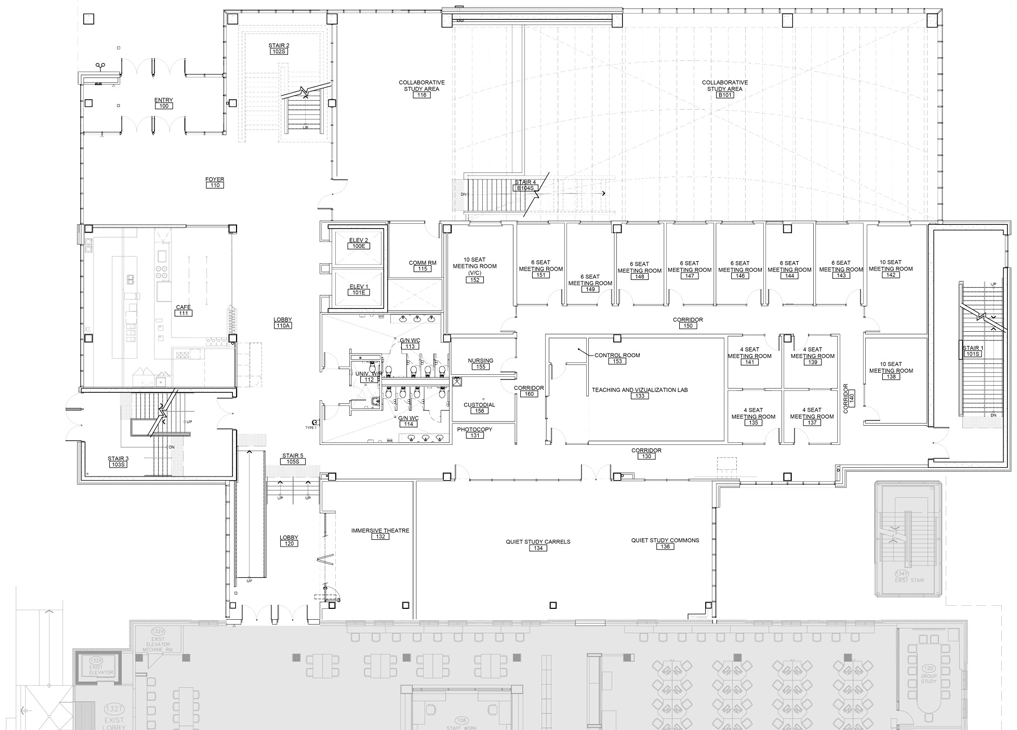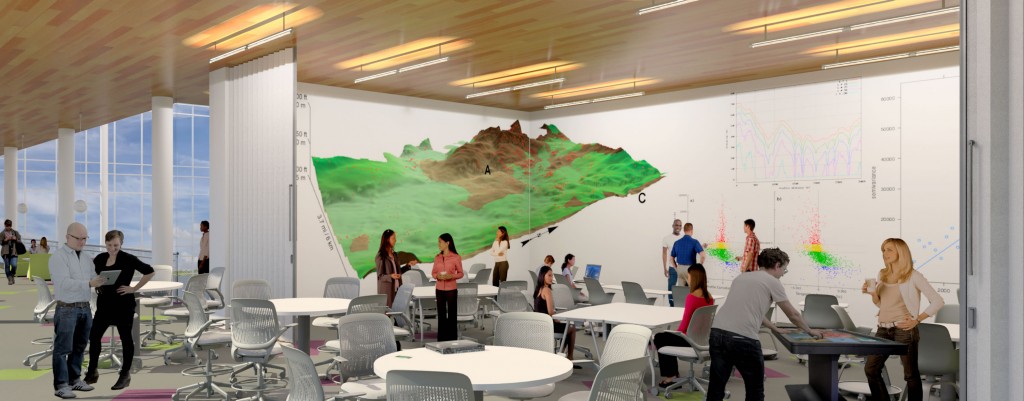
The Fitz Hall

The Fitz Hall:
The expansive two-storey great hall epitomises the features we aspire to create in the new facility. This ground-floor space of approximately 6,400 square feet will be an ideal space for fostering the collaboration and imagination of visitors. It will have an airy, atrium feel and will be the most prominent and visible space within the Commons. This is precisely the kind of space UBC Okanagan students have described: filled with flexible and adaptable areas whose furnishings can be easily reconfigured, from moment to moment, to suit the immediate needs of the users of that space.
Seating will accommodate 275 people, more than double the existing capacity of the current first floor of the adjacent Library. It will be used for a range of activities: gathering, socializing, mentoring, reading, individual and small-group learning, presentations and performances (in a series of large open areas not designated for quiet study), or simply hanging out. Most of the furniture will be organized into zones or clusters of small tables, large tables, and booth-style seating that provides space for small groups of people to work together, but still maintain some privacy, or to be seen by everyone, if preferred. Furniture will be moveable – with tables large enough to support collaborative learning – allowing students to arrange furniture as they choose.
Engagement Theatre
Engagement Theatre
$150,000 Naming Opportunity
The Engagement Theatre will be a public gathering and digital display space distinguished by its diverse opportunities for planned or impromptu, informal engagement – an ever-changing environment for the sharing of information, ideas, and creative works (academic and imaginative). These defining characteristics will be facilitated by its elemental features:
• Open floor plan (approx. 19’ x 29’, and 15’ high) and open access (three walls, not four)
• No formal seating (perhaps a few small, colourful, easily moveable stools)
• A prominent, expansive video wall (approximately 9’ by 20’)
• Multiple, directional (museum-style) speakers
Situated in a high-traffic area adjacent to the main hallway connecting the new Centre to the Library makes this an ideal space for visitors to convene for – and, ideally, for passers-by to stumble upon unexpectedly – a variety of engaging activities such as informal presentations, exhibitions, or gallery displays. This simply designed, open space will be an ideal location for:
• Showcasing digital, academic and creative works (video, multimedia, research, etc.)
• Conducting informal, public presentations, and TED-type talks
• Exhibiting visual art
• Displaying topical news and information (historic world events, election coverage, the Olympics)
• Exhibiting digitized versions of faculty and student conference posters
• Showcasing thesis defenses
• Engaging in community outreach activities
• Showing digital collections which offer a glimpse of resources available in the Library or Special Collections
• Screening photo or video collages/montage
• Running social media feeds (e.g. Instagram)
The composite nature of the video wall (i.e. multi-panel construction) will make it possible to display several digital productions on different panels simultaneously, and the directional speakers will make it possible to emit the accompanying sound from distinct, designated speakers, with minimal conflicting overlap of the different soundscapes. This opens up opportunities for some very immersive experiences. A content programmer could, for instance, simulcast multiple productions on different monitors, prompting a visitor to move from one point in the room to the next in order to listen to the corresponding audio for each video channel. For instance, one could display election-night news coverage from multiple news organizations so that a visitor could experience how each broadcaster is conveying the news to its audience at that same moment in time; or exhibit coverage of historic international events emanating from various countries around the globe.
This gallery space, regularly refreshed with new digital media, will be a vital and vibrant space, offering an engaging introduction to the campus – an enlightening window for campus and wider community members to view, engage with, and experience many of the research and knowledge-generation activities being undertaken on the campus.
Collaborative Study Rooms
Collaborative Study Rooms
$25,000 Recognition Opportunity (x7)
Recognizing the varying nature of collaborative work in different fields of study and professions, we propose to create a variety of spaces to facilitate different activities, and which also foster distinctive and preferred atmospheres. Every room will have the basics: tables and chairs. However, many of them will be equipped with additional resources. Some of the spaces will encourage a more informal or relaxed environment by incorporating a whiteboard for jotting down ideas, and a scattering of bean bag chairs in lieu of traditional ones. Others will be highly connected electronically, equipped with: computer workstations, monitors, and projectors, allowing team members to share ideas on the various screens; and microphones to simulate remote communications, allowing for video-conferencing. Since this type of technology is used regularly in workplace environments, allowing for remote collaboration on a common project, it would also serve as an excellent real-world simulation that prepares students for future employment. The technology would also allow each member of the group to leave the session with his or her own digital copy of the team’s effort.
Students are now required to break into groups to perform specialized analyses of given case studies. Engineers often scribble equations and ideas onto a whiteboard. Meanwhile management students might find greater benefit in workstations. These students would benefit greatly from case-study rooms, as the distinctive qualities of the space would accommodate and facilitate the collaborative work characteristics of their respective fields. A suite of case-study rooms will enhance the other types of study spaces that accommodate group and individual study throughout the new facility.
Large Collaborative Study Rooms

Large Collaborative Study Rooms
$50,000 Recognition Opportunity (x3)
Recognizing the varying nature of collaborative work in different fields of study and professions, we propose to create a variety of spaces to facilitate different activities, and which also foster distinctive and preferred atmospheres. Every room will have the basics: tables and chairs. However, many of them will be equipped with additional resources. Some of the spaces will encourage a more informal or relaxed environment by incorporating a whiteboard for jotting down ideas, and a scattering of bean bag chairs in lieu of traditional ones. Others will be highly connected electronically, equipped with: computer workstations, monitors, and projectors, allowing team members to share ideas on the various screens; and microphones to simulate remote communications, allowing for video-conferencing. Since this type of technology is used regularly in workplace environments, allowing for remote collaboration on a common project, it would also serve as an excellent real-world simulation that prepares students for future employment. The technology would also allow each member of the group to leave the session with his or her own digital copy of the team’s effort.
Students are now required to break into groups to perform specialized analyses of given case studies. Engineers often scribble equations and ideas onto a whiteboard. Meanwhile management students might find greater benefit in workstations. These students would benefit greatly from case-study rooms, as the distinctive qualities of the space would accommodate and facilitate the collaborative work characteristics of their respective fields. A suite of case-study rooms will enhance the other types of study spaces that accommodate group and individual study throughout the new facility.
Lois and Cliff Serwa Reading Room

Lois and Cliff Serwa Reading Room
Many users of our new facility will be seeking a chance for individual, quiet study, not collaboration or interaction. Providing an array of study options, including carrels for individual, focused work and treadmill desks for those seeking a wellness break, this will be the principal quiet study room on the floor and in the facility. Considering UBC’s Okanagan campus has embraced the mindfulness philosophy, at one end of this ground-floor, quiet-study space, we propose to create a mindfulness or wellness space – a distinctive refuge of stillness within the new Commons – for meditation, yoga, or simply relaxation. The area will be uncluttered and include yoga mats which visitors will be able to pull off of a shelf and sit on. The room will also include corresponding mood lighting, a sound system (speakers or headphones) with quiet music and perhaps a menu of guided meditation for individual use. Large windows will form the wall to one end of this room, allowing for natural light to fill the space, and the outlook will be of a small garden that will enhance the internal atmosphere of calmness. This space should constitute a fitting counterpoint to the kinetic engagement which the overall facility has been designed to facilitate.
Teaching and Visualization Lab

Teaching and Visualization Lab
$250,000 Naming Opportunity
The Teaching and Visualization Lab will constitute a highly flexible or reconfigurable space designed to support high-definition visualization and simulation. The processing power of the lab’s computers and the room’s expansive screen capacity open up exciting new possibilities for teaching and learning which cannot be realized with a conventional computer and monitor. This facility can help its users to display complex and abstract concepts in easy-to-perceive visual renderings, detect and convey meaning more effectively, and improve an audience’s understanding more compellingly.
Visualization means different things to different people, and use of the lab’s various capacities will vary according to the needs and imaginations of its users. Nevertheless, our researchers will be able to explore data in ways that have previously been unavailable to them. The room could serve a variety of needs and purposes, including high-impact presentations, technology-rich interactive learning in small groups, large-scale high-definition visualization and simulation, command/control room simulation, immersive interactive computing, game research, ‘big data’ demonstration space (for graphic modelling of large quantities of detailed data), and comparative social computing. The lab will allow:
• Ecologists to digitally map complex and often interrelated ecosystems
• Biologists to display and examine microscopic cellular details
• Sociologists to generate complex visual representations of interrelated population data
• Digital humanities researchers to plot intricate networks of relationships in various dimensions (in space and across time)
• Computer scientists to develop computer-aided software for optimizing road, railway, and pipeline design
The Lab's flexible infrastructure will be designed to grow over time with the rapid advancements that are being made in visualization and display technologies. Sample functions could include: 270-degree immersive projection on three walls; 3-D capability; professional, zoned audio system; and cameras for real-time video capture, broadcast, and collaboration.
Many faculty members will find this space provides intriguing opportunities for occasional classroom instruction or lecture demonstrations. It will also ensure our students have the opportunity to embrace the latest technology and learn cutting-edge digital skills. Since no similar facility currently exists on the UBC Okanagan campus, this is one of those spaces whose full potential may not be realized until it is available for use.